
The best online fitness resource you'll ever need. We filter out the BS to ensure you meet your health and fitness goals!

The best online fitness resource you'll ever need. We filter out the BS to ensure you meet your health and fitness goals!
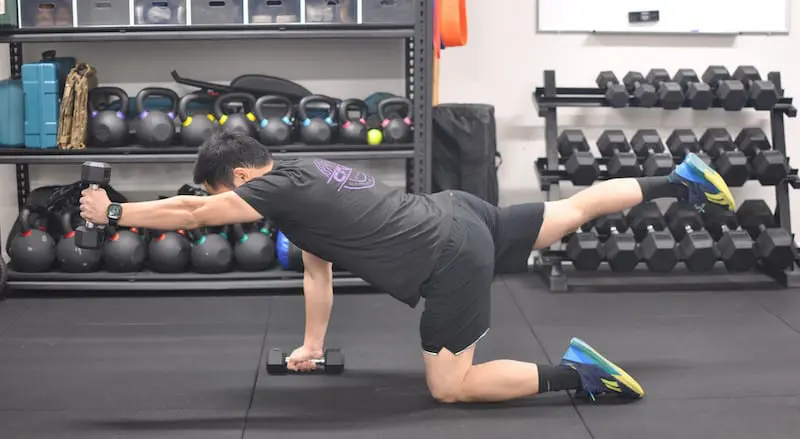
We don’t think much about our lower backs until they hurt or until they stand in our way of doing our favorite exercises or activities. That’s why we’ve devised a list of the 10 best lower back exercises with dumbbells to help address that situation.
The lower back is part of the core and the muscles that compose it are not isolated to just the lower back. They’re hidden by other muscles we tend to give more attention.
It makes sense to show our lower backs a little love to make sure they’re in good shape and stable and dumbbells are a good way to train them.
Let’s first take a look at the muscles of the lower back to give you an idea of what you’ll be working.
The major muscles commonly associated as being only lower back muscles actually run the entire length of the back. These are the erector spinae muscles
There are other important tiny muscles that help stabilize and move each joint in the backbone. You need to know this if you want to be smart in how you train your back.
It’s important to remember that the muscles commonly referred to as the lower back muscles are not isolated to the lower back. They begin low and run up the spine to attachments along the spinal column.
The muscles of the lower back that you can see are the origin of the iliocostalis, which is visible near the pelvis but is covered by other muscles you *can* see in the middle and upper back.
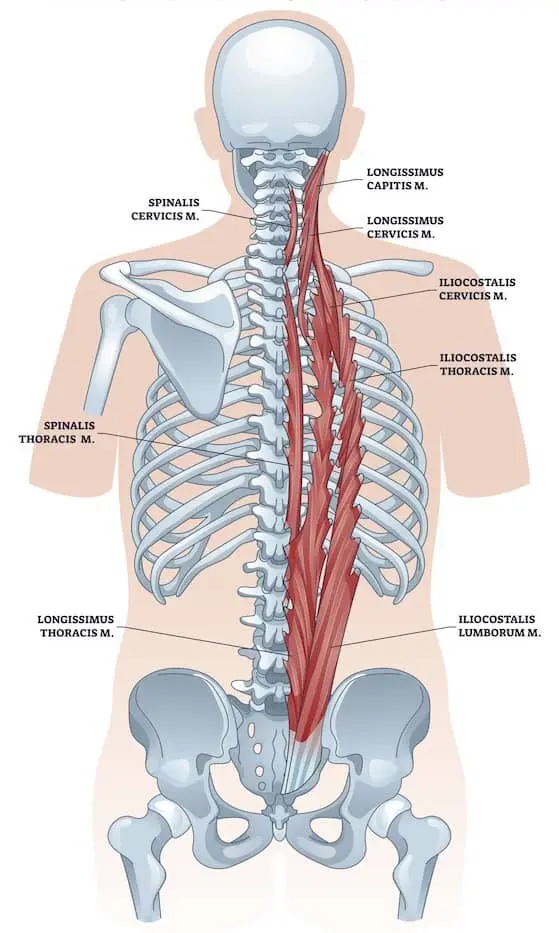
The deeper muscles are the longissimus, the spinalis, the multifidus, and the quadratus lumborum.
The quadratus lumborum is responsible for hiking the hip on one side or the other, so we don’t routinely think of it as a “back muscle” – more of a hip muscle from a functional point of view.
There are some tiny muscles that support the vertebrae along the spine and help us bend and twist. We won’t go into them here other than to say that they’re important, and because they’re small, they remind us that it’s important to keep our backs strong and avoid risky exercises that put the spine overall at risk.
The internal obliques are technically also low back muscle, but again, we ordinarily associate it with the core, which is correct. Nevertheless, it’s oriented in the lower back so we’re naming it here.
Exercises thought of as training the lower back actually train the deep spinal muscles along the entire back. The visible muscles of the back cover these for all but the very lowest portion near the waistline where the erector muscles can be seen under the lats.
Related: Best Erector Spinae Exercises
A lower back exercise should first–and obviously–address the muscles of the lower back in a way that works them directly and safely.
A great lower back exercise will take into account that the lower back muscles are in an area renowned for injury, and that not raining them intelligently adds risk. In other words, while trying to work the lower back to prevent injury, you can end up injuring it in the process.
Lower back exercises should use appropriate amounts of weight, exercises that are easy to do, and that are easy to learn and perform with perfect form.
With that said, we’ve rated the effectiveness of each lower back exercise using the following three factors:
Dumbbells were one of the original training tools dating back centuries and they’ve lasted this long for good reasons. They work!
They can be used as singles, or as a pair. Weights can be very light or quite heavy. In the case of training lower back, dumbbells work better for exercises that require a lighter weight, and where the pathway of the exercise is better suited.
Barbells of course can be used for training the lower back. Exercises like Good Mornings and Romanian Deadlifts are done with barbells all the time. Dumbbells simply allow for greater range of motion due to the absence of a bar getting in the way.
They also just make these movements more comfortable and remove some of the injury risk.
Here are 10 dumbbell exercises you can use to build and strengthen your lower back. We’ve ranked them in descending order of effectiveness, beginning with the best of the best.
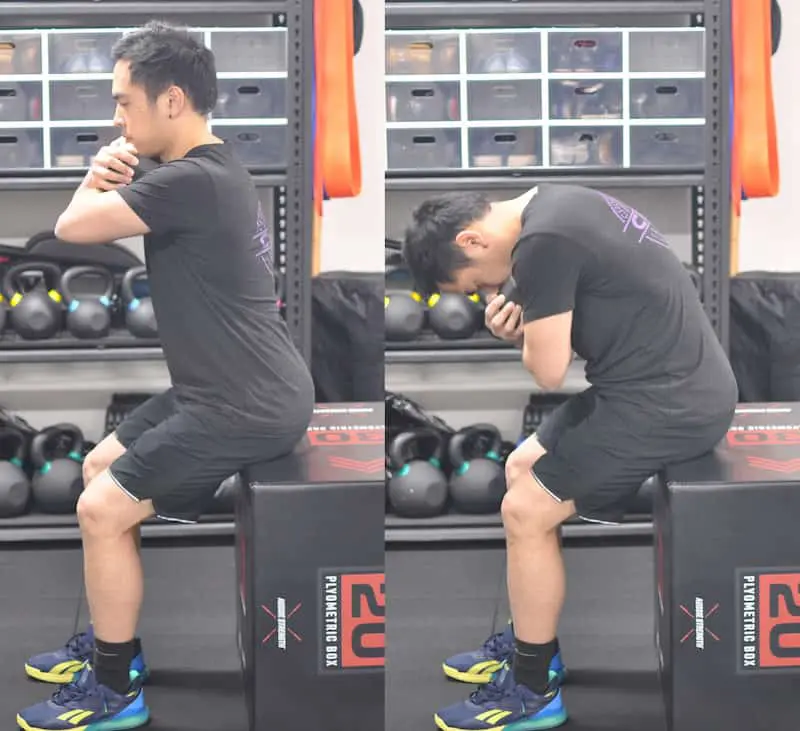
The Seated Back Curl is a very simple yet effective exercise. It works the back muscles in exactly the way they are intended to function.
All you need is a place to sit and a light dumbbell. Even the strongest people will benefit from nothing heavier than a 15kg dumbbell. A kettlebell also works.
To do a Seated Back Curl:
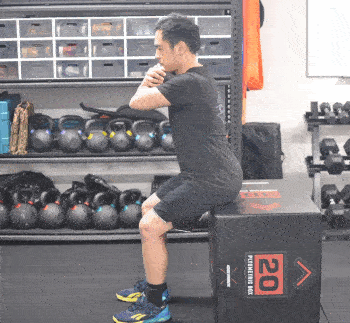
This simple little exercise isolates the erector muscles from one end to the other. The erector muscles start at your hips and go all the way up to your neck, even though you can only see them near your waist because the lats and traps cover them.
OUR RATING
A+
Seated Back Extensions are very specific to the erector muscles, super-easy to perform, and virtually risk-free. The best of the best for lower back and overall back strength and stability.

The Superman exercise is most often performed using bodyweight. Holding light dumbbells progresses it to make the exercise more challenging. Ankle weights add even more difficulty.
The Superman is part isometric, part dynamic exercise. The body is raised into the flying Superman position and then held for a long pause.
The Superman exercise form doesn’t change from the bodyweight version.
To do a Dumbbell Superman:
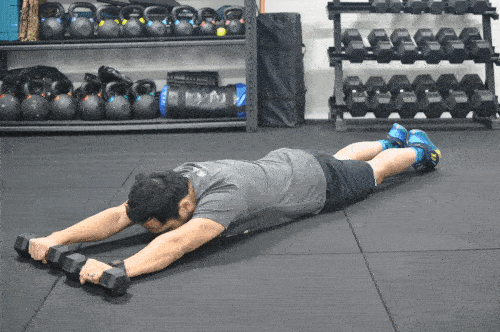
OUR RATING
A
Very low risk for injury (unless you use too much weight) and easy to perform. They do isolate the lower back to a degree. In fact, if you could raise your chest off the floor without raising the legs as well, Supermans would be an isolator. They’re #2 on our list because they’re a combination of isometric and dynamic, and dynamic exercises are believed to be better at muscle building.
You’ll obviously need a Roman chair for this movement. Most gyms have at least one roman chair. If you don’t have access to one, you can use a regular incline bench with the gap as the foothold.
The Roman chair back extension is most frequently seen performed by holding a barbell plate, but in this version we’ll be using dumbbells.
To do a Roman Chair Back Extension:
OUR RATING
B
Roman Chair Back Extensions do indeed exercise your lower back. They’re an OK way to do this. Risk is higher because good form demands strict control and not hyperextending the back at the top, which everyone seems to do. There’s also a tendency to “whip” the upper body upward, which only adds to the risk. Our opinion: Opt for Seated Back Extensions instead.
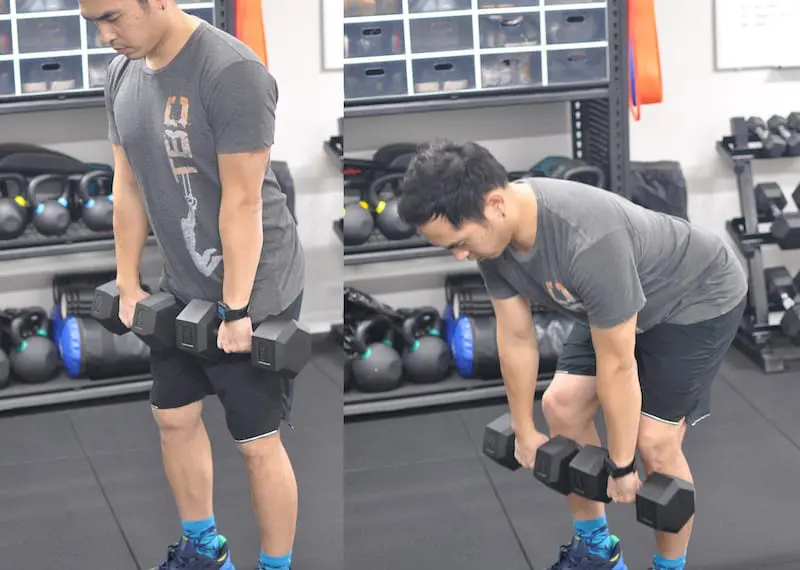
Dumbbell Romanian Deadlifts became a gym staple, as people became more conscious of their glutes, and well-developed butts became more fashionable. In addition to working the glutes, the lower back muscles must also work to provide stability throughout the exercise. They therefore work isometrically, meaning that they are not themselves moving during the exercise; they stay rigid and fixed as the hips move.
Dumbbell RDLs are also called Dumbbell Hip Hinges. “Hinging” is the mechanical motion the body follows. The knees are kept slightly bent and do not drive the weight by pressing into the floor as would be done with a conventional deadlift.
To do a Dumbbell Romanian Deadlift:
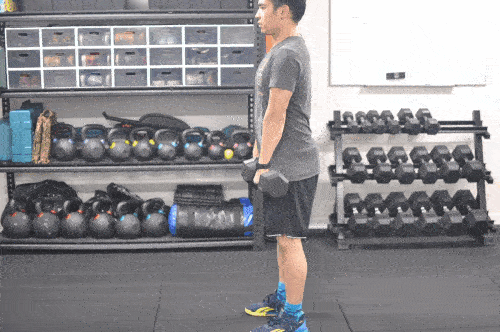
Dumbbells provide a more comfortable lifting experience than their barbell RDL cousins because the hands can assume a more natural position and stay close to the legs.
OUR RATING
B
Dumbbell RDLs are a compound exercise for the posterior kinetic chain–those muscles that compose the backs of the legs, hips, and back. They’re not a lower back isolation exercise, and the work is isometric… not exactly what we look for in resistance exercise. Dumbbell RDLs appear simple but hinging requires practice and sometimes some coaching. Unless you’re trying to do way too much weight, risk of injury is low to moderate.
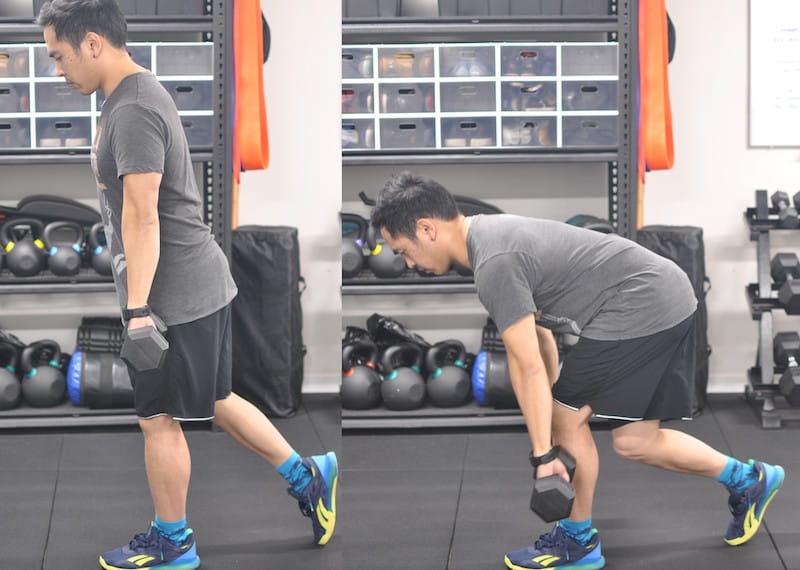
Dumbbell Kickstand Deadlifts are a single leg version of Dumbbell Romanian Deadlifts that get their name from the trailing “support” leg serving like a kickstand on a bicycle.
Instead of lifting the trailing leg off the ground, the trailing leg remains in contact with the floor only slightly by touching the toe. The trailing foot does not push in any way.
Dumbbell Kickstand DLs can be done using a dumbbell in each hand, or in just one hand.
To do a Dumbbell Kickstand Deadlift:
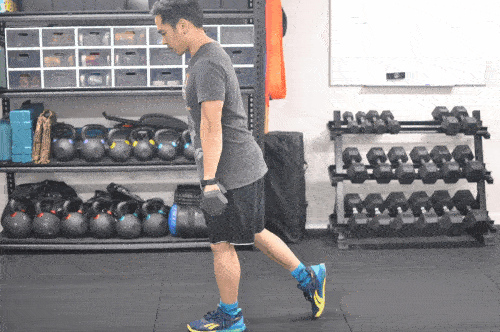
Kicking the non-working leg back is pointless. Doing so only counterbalances the dumbbell’s weight, forcing you to use a heavier dumbbell to get the same effect by compensating for the weight of your leg that you’ve extended behind you.
Fortunately, the leg kickback version is falling out of favor as more people discover the superior kickstand version. Kickback DLs look dumb and they are dumb, when you can get better results kickstands offer.
OUR RATING
B–
Like Dumbbell RDLs, Kickstands are a compound exercise for the posterior kinetic chain. By design, you can’t do as much weight, which eliminates some of the risk, but on the other hand, you work from a less stable stance, and that adds some risk back in. Bottom line is they’re not ideal for lower back work.
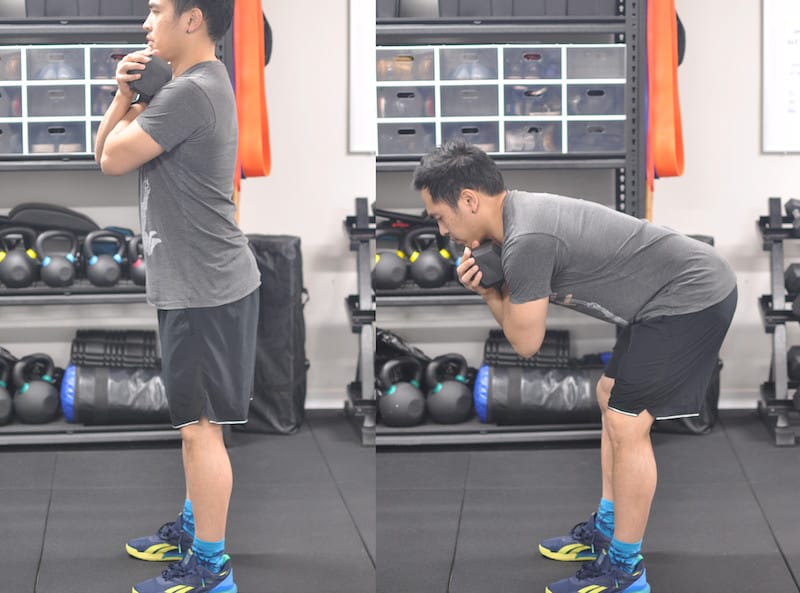
Take a Dumbbell Romanian Deadlift and hold the weight(s) near your chest and shoulders instead of at arms’ length, and you’ve got a Dumbbell Good Morning.
They’re a little more challenging than the Dumbbell RDL due to the arm and shoulder work required to keep the dumbbells pinned to your upper body instead of simply hanging there. And you lose the visual cue of the dumbbells tracking up your legs, which helps with proper form.
To do a Dumbbell Good Morning:
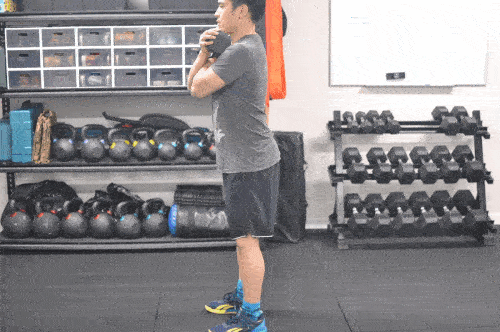
OUR RATING
B–
The challenge with the Dumbbell Good Morning is the temptation to use too much weight, and risk rises along with the poundage. That alone forces this down our list. People just can’t resist the temptation to use too much. A couple of 10kg DBs is more than enough to provide overload, even for the strongest. Not much weight is required for a generous dose of work to the erectors.
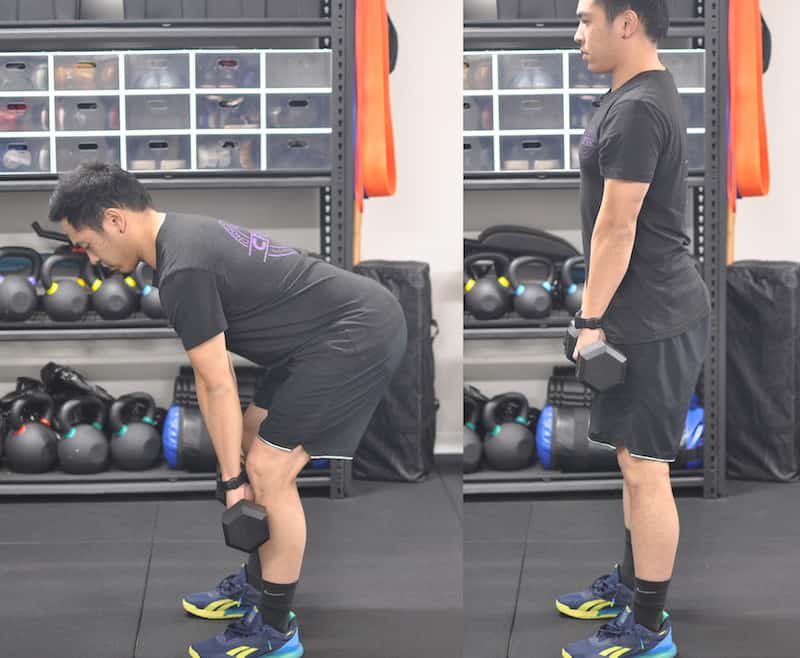
Dumbbell Stiff Leg Deadlifts closely resemble Dumbbell RDLs. The difference is that there’s no hip hinge. You bend forward at the waist while the hips stay in position. Knees are slightly bent in both.
To do a Dumbbell RDL:
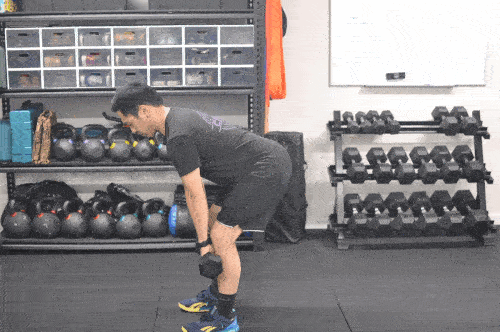
Dumbbell Stiff Leg DLs are not “straight leg” deadlifts. “Stiff” means that the knees remain fixed in the very-slightly bent position, not locked out or hyperextended.
True straight leg deadlifts lost popularity because they put the hamstrings at risk from the over-stretch caused by completely straight knee lockouts.
OUR RATING
B–
Bending forward at the waist raises the risk of injury, and the hamstrings and glutes are more involved than they should be for a lower back exercise. Risk and lack of specific benefit are why we can’t rate Dumbbell Stiff Leg Deadlifts any higher.

Birddogs are a staple of physical therapists and personal trainers alike for developing isometric core strength. Because the lower back muscles compose part of the core, including birddogs in a lower back training program makes some sense.
Bodyweight birddogs are challenging by themselves but once you’ve mastered them, you can progress them by adding light weight. Light weight is defined as weights you can hold steady in the birddog position for a few seconds.
Pair the dumbbells with ankle weights to balance the load between arms and legs if it adds stability.
To do a Dumbbell Birddog:
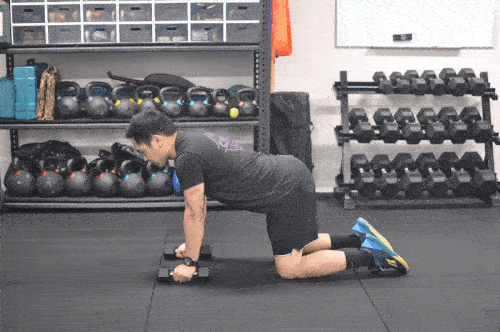
OUR RATING
B–
Dumbbell Birddogs are a reliable core exercise and provide some minor overload to the erector muscles along the entire back when performed with perfect form. Form can be a problem.
They do require excellent form, so not that easy to do well. Risk of injury is low. They do not specifically address the lower back as well as other exercise choices.
They’re a decent all-around isometric core exercise and a good selection for rehab from hip or lower back surgery when done under professional supervision.
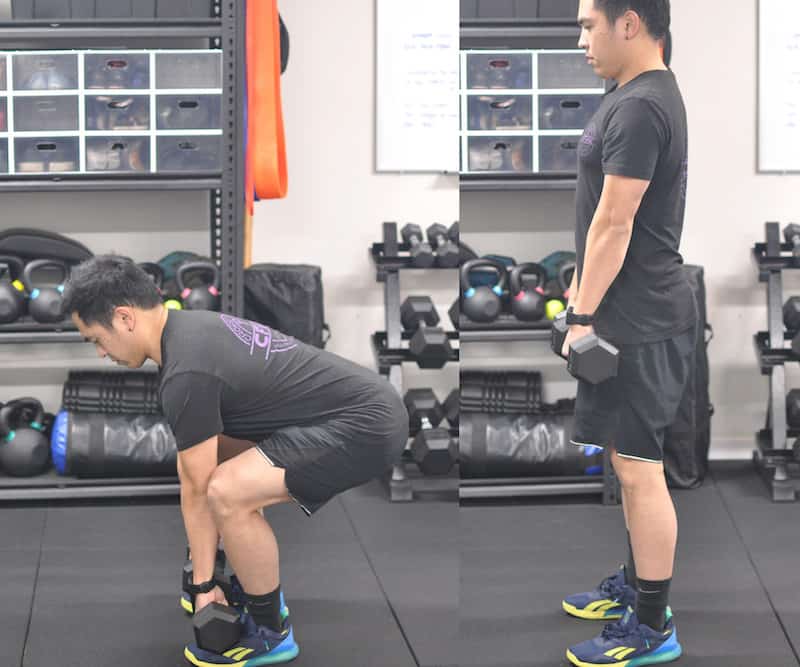
Squats or deadlifts? Seems no one can agree.
The Dumbbell Deadlift involves two moderately heavy to heavy dumbbells gripped and pulled from the floor for reps. The weights should only kiss the floor between reps. Heavy is relative… ”heavy” is whatever is heavy to you. The back is kept perfectly straight and the amount of forward lean depends on the anatomy of the lifter.
To do a Dumbbell Deadlift:
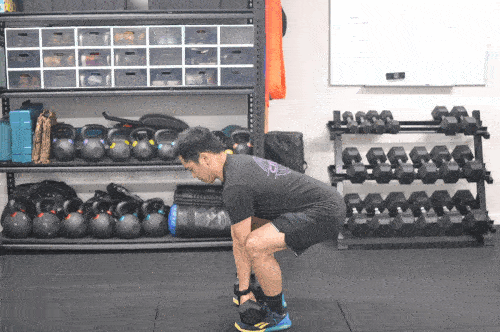
OUR RATING
C
Dumbbell Deadlifts are a total body exercise…nowhere near a lower back isolator. The entire back gets involved. So “yes” the lower back gets a decent dose of overload.
Dumbbell DLs are next to the bottom of our list because they are not specific to the lower back (you have no idea exactly how much the lower back is contributing) and because of the risk related to lower back fatigue. Dumbbell Deadlifts take a lot of energy; the back tends to round forward as you tire.
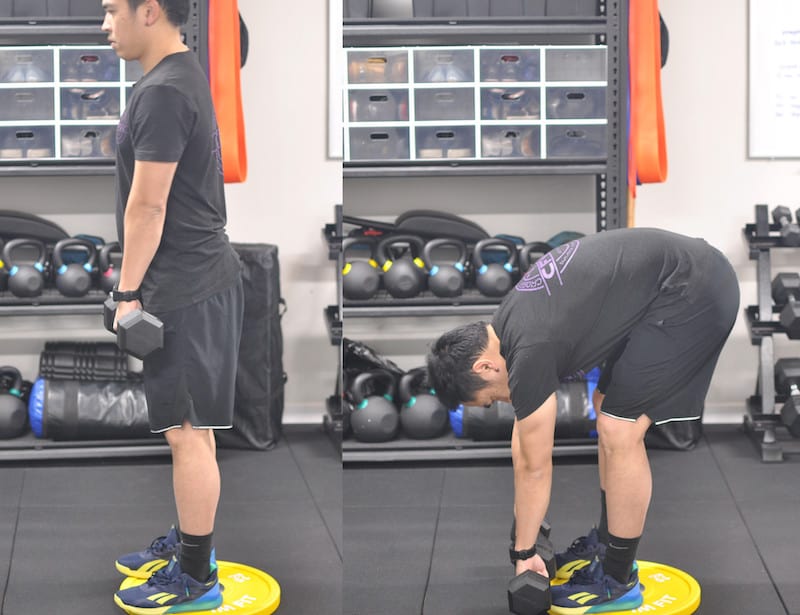
Jefferson Curls are–more or less–a Dumbbell Stiff Leg Deadlift performed by letting the back sag forward at the shoulders, and then curling it back up to perfectly straight as you lift. Think of it as a combination of our Seated Back Extension and a Stiff Leg Deadlift.
You’ll need a short box, riser, or a bumper plate to do a Dumbbell Jefferson Curl.
Here’s how to do one:
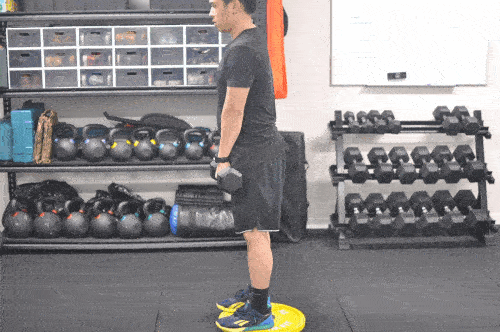
The Jefferson Curl works the erector muscles as well as the lower traps because of the need to pull the shoulder blades back into position during the upward movement.
OUR RATING
C–
Jefferson Curls are very difficult to do well and safely. The risk of low back strain is high, mainly because dudes can’t resist using too much weight and perfect form is demanding even though it seems simple.
The lift is done from slight elevation to accentuate the stretch in the bottom, which adds to difficulty and risk. Newbies to the gym should not attempt Jefferson Curls.
If working your lower back is your objective, you’re best served by selecting an exercise that focuses on it alone and lets you work it safely. Lower back injury can put you on the sidelines and keep you out of the gym for a long time.
Lower back pain is a major health issue. The CDC reports that 25% of Americans reported some kind of back pain during the past three months. Pills aren’t the answer. Back pain became a leading factor in the opioid addiction epidemic.
Exercise and proper movement function in activities of daily living prevents injuries that lead to both acute (temporary) and chronic back pain.
Good posture has become a rarity. Personal electronics and desk jobs have been a major contributor to poor posture. Shoulders are rounded and backs are hunched over.
A rounded upper back keeps the lower back under constant load, and sets up the conditions for back pain and dysfunction.
Not only that, a rounded back compresses the chest, so that proper breathing is affected. Try taking a big, deep breath while hunched over, and then with a straight back and shoulders to prove the point for yourself.
Our lower backs allow us to bend and twist, and support our upper bodies. Obviously, having a strong lower back is pretty important.
Anyone who’s hurt their lower back completely understands how much our lower backs are involved in what we do every day. Everything seems to be connected to it, because it pretty much is.
We use our lower backs passively to sit, stand, and walk. We use them dynamically to do everyday things like bend over to pick up our book bags, get in and out of a vehicle, or put a baby in a high chair. And of course we use our lower backs in the gym when we pick up dumbbells or barbell plates.
You don’t need a back as strong as a competitive lifter, but you do need one that’s strong enough for your level of activity.
No. Only an energy deficit (aka calorie deficit) implemented intelligently over time will reduce body fat.
Lower back exercises can add muscle tone so that once the fat stores are reduced, you’ll be left with a more shapely middle.
Fat loss is achieved in the kitchen and not in the gym.